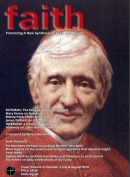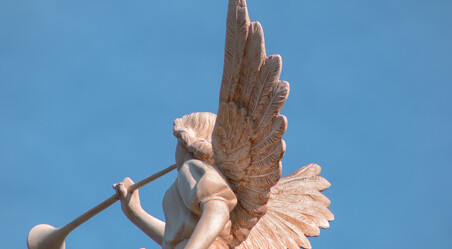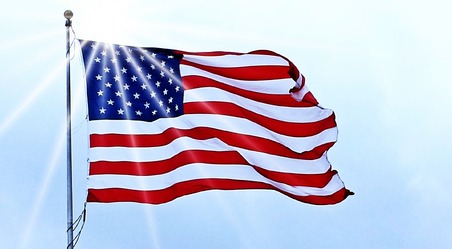Catholic Education in the 21st Century
Roy Peachey FAITH Magazine November-December 2013
Roy Peachey is an English teacher and director of learning at The Cedars, an 11-18 school for boys in Croydon. In this article he reflects on recent developments in Catholic education.
Changes in the World of Catholic Education
These are exciting times for Catholic education and, mirabile dictu, much of the excitement is being generated here in the UK. When I wrote a couple of articles for this magazine in 2011 about the need to Catholicise the English curriculum, I did so more in hope than in expectation. However, a mere two years later, the nature of Catholic education in the UK has already begun to change dramatically.
A number of different strands have come together to effect this change. In the field of higher education, for example, several new institutions have been founded. The Benedictus College of the liberal arts in London is now offering a one-year foundation programme in European culture and thought as a prelude to its full degree programme. The St Andrew’s Foundation for Catholic Teacher Education, which was set up at the University of Glasgow in 2012, had its official launch in 2013 with the Prefect of the Congregation for the Doctrine of the Faith, Archbishop Gerhard Müller, giving an address on the topic of Catholic education. The Jubilee Centre for Character and Values at the University of Birmingham, an “interdisciplinary research centre focusing on character, virtues and values inthe interest of human flourishing”, also opened its doors in 2012. Though it is not a Catholic institution, many of the leading figures at the centre, including Professor James Arthur, its director, are Catholics and much of its work fits in well with Catholic educational thinking.
''For the educated person cannot play his full part in modern life unless he has a clear sense of the nature and achievements of Christian culture: how Western civilisation became Christian and how far it is Christian today and in what ways it has ceased to be Christian''
Similar developments have taken place in secondary education too. The most notable, for me, was the decision of the PACT Educational Trust, which already runs two prep-schools, Oakwood School in Purley and Oliver House in Clapham, to move into secondary education. The Cedars, an 11-18 school for boys in Croydon, and The Laurels, an 11-18 school for girls in Clapham, took their first pupils in September. Not that I’m an entirely objective observer: I am director of learning at The Cedars.
The Cause of the Changes
So why have these changes come about? The beatification of John Henry Newman has certainly made a difference, bringing his educational (as well as his theological) ideas into the spotlight. More significant, though, has been the continuing impact of Benedict XVI, who at the beatification Mass in September 2010 paid “particular tribute to [Newman’s] vision for education, which has done so much to shape the ethos that is the driving force behind Catholic schools and colleges today. Firmly opposed to any reductive or utilitarian approach,” Benedict said, “he sought to achieve an educational environment in which intellectual training, moral discipline and religious commitment would come together.” In much the same way that the pontificate of Benedict XVI created the environment for a renewalof the liturgy, so too did his pontificate gradually bring about change in the world of education.
It was Benedict XVI’s visit to Britain which encouraged the directors of PACT to put into operation their long-cherished plan to set up two secondary schools, and it was his words that gave the Benedictus College for the liberal arts its impetus. As is explained on its website: “The college will develop and enrich the cultural and educational life of our country; and respond to Benedict XVI’s call for a New Evangelisation, bringing life to ‘the interior desert that results when man, wishing to be the only builder of his own nature and his own destiny, finds himself devoid of that which constitutes the foundation of all things’ ” (Motu proprio Ubicumque et semper, October 2010).
The Church has, of course, always held education in high regard, but it is certainly possible to argue that Benedict XVI brought new life and new impetus to Catholic education at a time when it was in danger of losing its direction. I am even tempted to go so far as to suggest that the pontificate of Benedict XVI created the conditions for what we might dare to call a New Educational Movement.
An International Movement
One of the most positive sides to this new educational movement (which, to be fair, doesn’t yet quite deserve the capitalisation) is its international dimension. The launch of the St Andrew’s Foundation by Archbishop Müller and the message of support sent by Pope Francis are indications of a broader international picture. An Anthology of Catholic Teaching on Education (Scepter, 2007) may have been collated and edited by the head of the foundation, Leonard Franchi, but it was Cardinal George Pell from Sydney who provided the illuminating and challenging preface.
Similarly, one reason the most recent edition of Communio, on Catholicity and education, was so interesting was the international scope of its contributors: not just David Schindler and Adrian J Walker from the US, but Jean-Luc Marion and Rémi Brague from France, and Robert Spaemann from Germany.
What is apparent from these publications and others like them is that Catholic education has faced similar challenges across the globe. For example, in a recent analysis published in an edition of International Studies in Catholic Education dedicated to the question of whether there can be such a thing as a Catholic curriculum, Therese D’Orsa argues from the Australian experience that “attempts to give meaning to the concept of a Catholic curriculum … have ranged across a spectrum familiar to those who lead in Catholic schools” and that such initiatives have had a “limited impact”.
The most common approach, she argues, has been to give RE a central place in the school curriculum. It is an approach G K Chesterton identified and criticised in his essay “The New Case for Catholic Schools”, published in 1950 as part of a collection entitled The Common Man: “If Catholics are to teach Catholicism all the time, they cannot merely teach Catholic theology for part of the time. It is our opponents, and not we, who give a really outrageous and superstitious position to dogmatic theology. It is they who suppose that the special ‘subject’ called theology can be put into people by an experiment lasting half an hour; and that this magical inoculation will last them through a week in a world that is soaked through and through with a contrary conception of life.”If it is left entirely to the RE department to create a school’s Catholic identity, the inevitable result is that other subjects tend to become permeated (at best) or dominated (at worst) by an antipathetical, secularised philosophy.
A second approach has been what she calls values integration, one version of which “seeks to incorporate various themes such as social justice, peace, the environment, etc, into the total life of the school so that the student may incorporate the Catholic values demonstrated in the way the school lives the theme”. Values integration is not a phrase widely used in the UK, but it suggests a word which is widely used: ethos. The danger here is that the full glory of the Catholic faith is replaced by a bland, and sometimes only tangentially Catholic, ethos which offends no one but satisfies no one.
A third approach, D’Orsa suggests, has been to seize opportunities as they arise to make connections with Catholic faith and values. The obvious problem here is that it’s just too hit and miss, partly because it relies heavily on what is increasingly rarely found in our Catholic schools: well-formed, highly committed, Catholic teachers. As James Arthur points out in another essay in the same journal: “Between 1978 and 1993 the percentage of non-Catholic teachers in maintained Catholic schools increased from 22\% to 29\%. Between 1993 and 2011 this percentage increased to 45\%, with the pace of change accelerating annually. … This set of statistics may even be an underestimate of the direction of travel as … Catholic schools and colleges often feel under pressure to demonstrate theirCatholicity and can inflate actual numbers in their ‘self-declaration’ of Catholic staff and pupils.”
Signs of Hope
So much for the all too well-known problems that have afflicted Catholic education. What about the solutions?
The very existence of the St Andrew’s Foundation for Catholic Teacher Education is a source of hope (and maybe of some envy to those of us south of the border). Its legacy may well be the formation of the well-formed Catholic teachers whose absence James Arthur notes; and its presence may also provide not just inspiration but also a model for teacher training elsewhere in the UK.
The Jubilee Centre for Character and Values offers something quite different: what its director has called a “return to virtue”. At its heart is a mission to develop the virtues in order to facilitate the development of character, which suggests that it is rooted in a vision of Catholic education shaped by St Augustine, St Isidore of Seville, Alcuin and St Thomas Aquinas.
The focus of the Jubilee Centre reminds us that we need to reach further back into history than we have been accustomed to if we are to revive Catholic education: in particular, we need to learn from the great Catholic schools and universities of the pre-Reformation era. We need to be reminded that it was once taken for granted that authentic education was built upon the teaching and practice of the human and theological virtues, that education, as St Thomas Aquinas put it, is “the progression of the child to the condition of properly human excellence, ie to the state of virtue”.
“There is no real education without personal responsibility, and there is no responsibility without freedom”
If true education is an education in the virtues then we can begin to see a link between the work of the Jubilee Centre and the work of the Benedictus College of the liberal arts, which places itself in a tradition stretching back through Blessed John Henry Newman, St Thomas Aquinas and St Augustine to Aristotle.
As the Benedictus Trust website explains: “In his book The Idea of a University Bl John Henry Cardinal Newman asserts that the primary purpose of a university should be to teach theoretical knowledge, following the distinction made by Aristotle in the first book of the Nicomachean Ethics between moral and intellectual virtues; the moral life concerned with practical knowledge and the intellectual life primarily concerned with theoretical knowledge – that is, ‘knowledge for the sake of itself’. This principle underlies the single, integrated programme of studies at Benedictus; its breadth and rigour will reconnect all the disciplines with what Mgr Ronald Knox referred to as the ‘Hidden Stream’, the Christian basis of European culture and tradition.”
This link between the virtues and the liberal arts can also be seen in the work of the two new PACT schools, The Cedars and The Laurels. Both place great emphasis on developing human virtues, or strength of character, because these virtues enable a person to be truly free. Drawing on St Josemaria Escriva’s writings, including the insight that “there is no real education without personal responsibility, and there is no responsibility without freedom”, the two schools emphasise freedom in education: not freedom from constraints but freedom as the capacity to carry noble convictions into action.
The PACT educational vision is therefore underpinned not just by the idea that the parents are the first educators of their children, with all that that entails (including the understanding that “the family is the first school of those social virtues which everyday society needs”, as the Second Vatican Council’s Declaration on Christian Education puts it), but also by the idea that an education in the virtues is the basis of genuine freedom. In taking a liberal arts approach to education, therefore, The Cedars is not attempting to turn back the clock or to Americanise British education. Rather, it aims to create the means by which children can be formed for true freedom.
What this means in practice needs some spelling out because, as Leonard Franchi at the University of Glasgow and his colleague Robert Davis point out: “The conjoining of ‘Catholic’ and ‘liberal’ in an essay about education needs further examination … owing to the (wilful?) misappropriation of the term ‘liberal’ by many social, cultural and political commentators of the day.” In their essay, Franchi and Davis take Benedict XVI’s call for the appreciation of an “authentic humanism” as the basis for their defence of the liberal arts, arguing that the Catholic vision of education is grounded in the search for wisdom and in a profound appreciation of the True, the Good, and the Beautiful.
The Cedars’ approach is to emphasise the interconnectedness of knowledge by drawing out links between subjects so that our pupils do not compartmentalise what they learn. In his essay “A New Humanism for Europe: The Role of the Universities”, to which Franchi and Davis refer, Benedict XVI puts it like this: “How urgent is the need to rediscover the unity of knowledge and to counter the tendency to fragmentation and lack of communicability that is all too often the case in our schools!” In our view, a liberal arts approach also emphasises a respect for the past; the significance of grammar, logic and rhetoric; and the notion, popularised by the historian Christopher Dawson, that ideas develop within cultures, which means that a grand narrative must necessarily underpin the curriculum.
What this grand narrative might cover also needs explanation. And Dawson, an Englishman who wrote The Crisis of Western Education while professor of Roman Catholic studies at Harvard University, can help us here. Convinced that “one of the chief defects of modern education has been its failure to find an adequate method for the study of our own civilisation”, Dawson argued that “the study of Christian culture … offers a new approach to the three great problems that confront Western education at our present time: first, how to maintain the tradition of liberal education against the growing pressure of scientific specialisation and utilitarian vocationalism; secondly, how to retain the unity of Western culture against the dissolvent forces of nationalism and racialism; and thirdly,how to preserve the tradition of Christian culture in the age of secularism.”
Dawson believed, as Glenn W Olson put it in a recent article in Logos, that “single-minded study of the classics and classical world had blinded people to the nature and significance of the Christian world that had grown up since antiquity. … Dawson thought it strange that 16th-century men should read so many pagan classics and, philosophy and theology aside, so little of the great Christian works that had subsequently appeared, especially works of the imagination like the Cid or Parzival that were built around the question of what it means to live the Christian life in the world.”
He believed, by contrast, that, whatever our own religious beliefs, we should be studying the growth and development of Christian culture (in its broadest sense) because it was Christianity which had created and shaped the culture we still live in today.
In The Crisis of Western Education he wrote: “I see no reason to suppose, as some have argued, that such a study would have a narrowing and cramping effect on the mind of the student. On the contrary, it is eminently a liberal and liberalising study, since it shows us how to relate our own contemporary social experience to the wider perspectives of universal history. For, after all, Christian culture is nothing to be ashamed of. It is no narrow sectarian tradition.
It is one of the four great historic civilisations on which the modern world is founded. If modern education fails to communicate some understanding of this great tradition, it has failed in one of its most essential tasks. For the educated person cannot play his full part in modern life unless he has a clear sense of the nature and achievements of Christian culture: how Western civilisation became Christian and how far it is Christian today and in what ways it has ceased to be Christian: in short, a knowledge of our Christian roots and of the abiding Christian elements in Western culture.”
Of course, a liberal arts approach to education underpinned by such a grand narrative is not the only possibility for Catholic educators. The Laurels School in Clapham, for instance, gives greater prominence to the development of sound philosophical understanding. As Melanie Clark, deputy head at The Laurels, explains: “Our approach, while acknowledging the liberal arts programme, is to equip our pupils with the ability to seek, find and love the true, the good and the beautiful wherever they may be found. In order for them to have the intellectual virtues to allow this to happen, we will educate in philosophical discourse and content. Our vision is to help our pupils and staff link together the different branches of knowledge to the Catholic Faith through philosophy, where the latteracts as the handmaid of theology.”
Of course, The Laurels and The Cedars are just two schools and much more could be said about the good work that is being done in schools across the country, about the sterling work done by Catholic home educators, and about a range of other initiatives including the steady growth of the Catechesis of the Good Shepherd and the projects arising out of Stratford Caldecott’s two books on education: Beauty for Truth’s Sake and Beauty in the Word.
Practical Issues
To finish, I would like to focus on some of the practical issues that impinge on all these groups. Though there is a growing awareness of the need for a genuinely Catholic curriculum, there is still little guidance on how to implement such a curriculum. We may wholeheartedly agree with James Arthur when he writes: “The idea that the school subjects that make up the curriculum (excluding religious education) are value-free and therefore somehow separate from the Catholic faith is clearly contrary to the Catholic worldview. … A school cannot be truly Catholic unless Catholicism and its values are diffused into the entire curriculum, methods, organisation and ethos of the school.” However, the problem of what Catholic schools should actually teach remains.
Part of the problem is the lack of suitable textbooks. One effect of the National Curriculum has been to create a market in which textbooks are much of a secularised muchness. If, as a 2010 report (“Doing God in Education”) by the think-tank Theos suggests, not even the teaching of modern foreign languages is immune from what it calls “the contemporary love affair with consumerist individualism”, where should Catholic teachers turn for their teaching materials?
One answer is not to use textbooks at all. A number of liberal arts schools in the US (The Heights in Washington DC being a good example) largely eschew textbooks for their older students and rely instead on the great books of the past. It is not unknown, for example, for mathematics to be taught through the medium of Euclid’s Elements. This approach is so far off the radar of most British schools that it is tempting to dismiss it as inherently unworkable. But, I would argue, there is no intrinsic reason why, for example, pupils should not be able to read and enjoy the whole of Bede’s History of the English Church and People when studying the Anglo-Saxons, or a Plato dialogue when studying philosophy.
The great advantage of such an approach is that it constantly reminds students that ideas do not exist in a vacuum, that what can too easily be presented as immutable facts are subject to revision, that science quite as much as any other subject is liable to paradigm shifts.
Another option is to turn to those parts of the English-speaking world that still produce suitable textbooks. The Didache series, for example, and the Catholic Schools Textbook Project, both from the US, are well worth considering. Another possibility, of course, is for publishers in this country to develop their own materials for Catholic schools. Sadly, there is little sign of such books being produced, other than for RE, at the moment but we can but hope that CTS and Evangelium, for instance, will one day move into this field. A final, more demanding and time-consuming, option is for Catholic schools to produce their own materials.
Such a discussion may seem terribly divorced from the everyday concerns of most readers, but in fact these practical issues lie at the heart of the current educational debate. Educationalists and theorists have argued the case for a Catholic curriculum for years now, but there has been little in the way of a response from those at the chalkface (or whatever the equivalent is now that interactive whiteboards have replaced blackboards).
What has changed over the past few years has not been Catholic educational philosophy – the desire to impart wisdom through the education of the intellect, and the desire to help pupils become saints through the education of the will. Rather, it’s that Catholic groups and individuals have decided to establish schools and institutions of higher education that take this philosophy seriously and seek to apply it in practice. If they are to succeed and flourish – and so enable the students who pass through their doors to succeed and flourish – the practical implications of Catholic beliefs need to be worked through.
A few years ago I would have wondered whether Catholic schools, universities and publishers were prepared to grasp that particular nettle. Now I feel a strong sense of hope.






